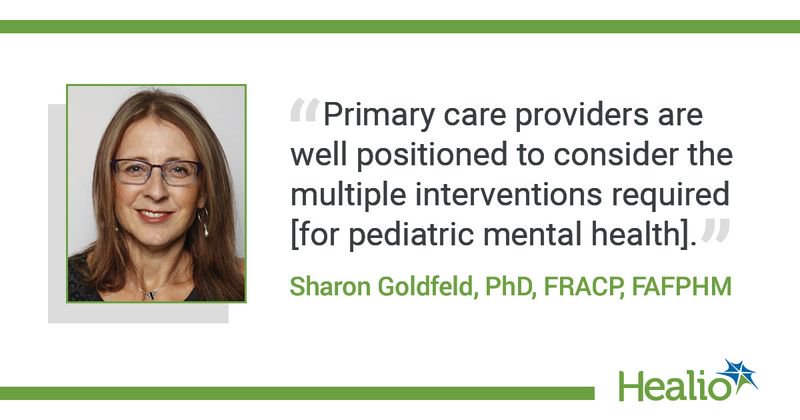Improving parental mental health can help reduce inequities in kids’ own mental health
Key takeaways:
- Researchers examined parents’ mental health and children’s school attendance.
- A broader, multipronged approach to treatment is necessary.
Improving the parental mental health and preschool attendance of disadvantaged children reduced socioeconomic differences in their mental health compared with nondisadvantaged peers, an Australian study found.
However, even when the two interventions were combined, disadvantaged children still had a higher prevalence of mental health problems, researchers reported.

“Mental health problems are a significant public health concern,” Sharon Goldfeld, PhD, FRACP, FAFPHM, director of the Centre for Community Child Health and professor of pediatrics at The University of Melbourne, told Healio.
“Children’s mental health is shaped by the environments where they live, learn, and grow,” Goldfeld said, “and children experiencing socioeconomic disadvantage are at greater risk of experiencing mental health problems.”
According to Goldfeld, “these inequities are preventable.”
“It is important to understand how interventions can be combined or ‘stacked’ to inform policy and achieve maximum impact, as there is potential to address the socioeconomic gap in children’s mental health,” Goldfeld said. “We know that early prevention is key, given the limited availability and accessibility of mental health services.”
What was needed, Goldfeld and colleagues surmised, was a “coordinated approach.”
“We estimated the extent to which child mental health inequities could be reduced by improving parental mental health and preschool attendance for children experiencing disadvantage,” Goldfeld continued.
The researchers used prospective nationally representative data from the birth cohort of “Growing Up in Australia: The Longitudinal Study of Australian Children,” which has had an every 2-year follow-up of 5,107 infants and their families since May 2004.
Ultimately, the researchers found that children experiencing socioeconomic disadvantage at age 0 to 1 year were nearly twice as likely to experience mental health symptoms at age 10 to 11 years than their nondisadvantaged peers.
Disadvantaged children were also more likely to have a parent experiencing psychological distress, 14.8% vs. 8.5%, and less likely to attend preschool, 60.9% vs. 69.3%.
Using hypothetical modeling, Goldfeld and colleagues estimated that improving the mental health of disadvantaged children’s parents and increasing their preschool attendance to match that of their nondisadvantaged peers could reduce 6.5% and 0.3% of socioeconomic differences in their mental health problems, respectively.
However, the researchers also estimated that, even after combining these interventions, disadvantaged children would still experience a 10.8% higher prevalence of elevated mental health symptoms.
“Any interventions alone, such as targeting single developmental periods, are unlikely to fully redress socioeconomic inequities in children’s mental health,” Goldfeld said. “Greater impact will likely require an integrated, multisectoral and sustained strategy by stacking diverse types of complementary interventions, such as improved parental support and preschool provision, over early childhood to optimize child mental health.
“This means primary care providers are well positioned to both consider the multiple interventions required, especially those upstream, and to connect with other local providers, especially for those families most likely to receive the least equitable care. As nonstigmatizing services, they are the perfect “front door’ for engaging families.”
Goldfeld and colleagues suggested that targeted policy interventions that improve parents’ mental health and preschool attendance for disadvantaged children should operate alongside other services and initiatives, including addressing socioeconomic disadvantage itself.
“Researchers must deliver a robust level of evidence needed to inform a coordinated stacked policy approach toward more equitable child outcomes,” Goldfeld said.
In an editorial published with the study, Rebecca A. Baum, MD, and Jessica Young, MD, MPH, both members of the faculty at the department of pediatrics at the University of North Carolina-Chapel Hill School of Medicine, said the findings “illustrate the importance of future research to confirm, or challenge, these results and to evaluate the effects of other combined interventions on children’s mental health.”
“Interestingly, even in [the researchers’] maximum benefit model, disparities in child mental health persisted,” they wrote. “Being able to better quantify the cost and impact of societal and individual interventions, both separately and in combinations of multiple interventions as modeled in this study, may help us build a better, and more equitable, society.”
References:
Goldfeld S, et al. Pediatrics. 2023;doi:10.1542/peds.2022-057101.
Young J, et al. Pediatrics. 2023;doi:10.1542/peds.2022-060264.
